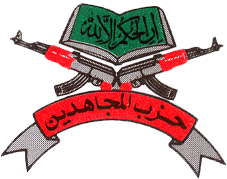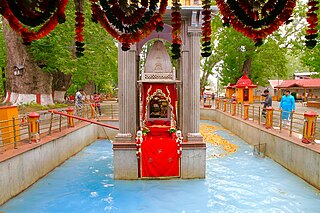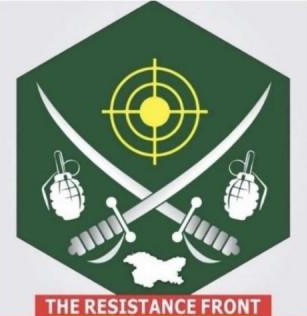Related Research Articles

Hizbul Mujahideen, also spelled Hizb-ul-Mujahidin, is a Pakistan-affiliated Islamist militant organisation that has been engaged in the Kashmir insurgency since 1989. It aims to separate Kashmir from India and merge it with Pakistan, and is thus one of the most important players in the region as it evolved the narrative of the Kashmir conflict by steering the struggle away from nationalism and towards jihadism.

The insurgency in Jammu and Kashmir, also known as the Kashmir insurgency, is an ongoing separatist militant insurgency against the Indian administration in Jammu and Kashmir, a territory constituting the southwestern portion of the larger geographical region of Kashmir, which has been the subject of a territorial dispute between India and Pakistan since 1947.
The 1998 Wandhama massacre refers to the killings of 23 Kashmiri Hindus in the town of Wandhama in the Ganderbal District of Jammu and Kashmir, India on 25 January, 1998. The massacre was blamed on the militant outfits Lashkar-e-Taiba and Hizbul Mujahideen. The victims included four children and nine women.

The Jammu Kashmir Liberation Front (JKLF) is a formerly armed, political separatist organisation active in both the Indian-administered and Pakistani-administered territories of Kashmir. It was founded by Amanullah Khan, with Maqbool Bhat also credited as a co-founder. Originally a militant wing of the Azad Kashmir Plebiscite Front, the organization officially changed its name to the Jammu Kashmir Liberation Front in Birmingham, England on 29 May 1977; from then until 1994 it was an active Kashmiri militant organization. The JKLF first established branches in several cities and towns of the United Kingdom and other countries in Europe, as well as in the United States and across the Middle East. In 1982, it established a branch in the Pakistani-administered territory of Azad Jammu and Kashmir, and by 1987, it had established a branch in the Indian-administered Kashmir Valley.

Kheer Bhawani,Ksheer Bhawani or the Ragnya Devi temple is a Hindu temple situated at a distance of 25 kilometres (16 mi) north-east of Srinagar, Jammu and Kashmir, India, in the village of Tulmulla in Ganderbal. It is dedicated to the Hindu goddess Kheer Bhavani constructed over a sacred spring. As is the custom with Hindu deities, the goddess has many names including Ragnya or Rajna, along with variations in honorifics such as Devi, Mata or Bhagavati. The term kheer refers to a milk and rice pudding that is offered to propitiate the goddess. Kheer Bhawani is sometimes translated as 'Milk Goddess'. The worship of Kheer Bhawani is universal among the Hindus of Kashmir, most of them who worship her as their protective patron deity Kuladevi.
The Chittisinghpura massacre refers to the mass murder of 35 Sikh villagers on 20 March 2000 in the Chittisinghpora (Chittisinghpura) village of Anantnag district, Jammu and Kashmir, India on the eve of the American president Bill Clinton's state visit to India.
The 2002 Qasim Nagar massacre was the killing of 29 Hindu labourers in Qasim Nagar on the outskirts of Jammu city in the erstwhile Indian state of Jammu and Kashmir by militants
The 1998 Chapnari massacre was a massacre of 26 Hindu villagers in Chapnari village in Doda district of Jammu & Kashmir on 19 June 1998, by terrorists belonging to Lashkar-e-Taiba and Hizbul Mujahideen.
The 1998 Prankote massacre was the beheading and killing of 29 Hindus in the villages of Prankote and Dakikote by militants in the Udhampur district of the former Indian state of Jammu and Kashmir on 17 April, 1998. The victims included 13 women and children. The houses of those killed were later set to fire. Survivors claimed that the killers had asked the villagers to convert to Islam and massacred the villagers after they refused. More than 1,000 villagers fled their homes in the area after the massacre. It also provoked outrage across India. The massacre was one of a series of massacres of Hindu villagers by militants in 1998.
1997 Sangrampora massacre was the killing of seven Kashmiri Pandit villagers in Sangrampora village of Budgam district of Jammu and Kashmir on 21 March 1997, by unknown gunmen. While militants have been thought behind the killings, police closed the case as untraced.
The Special Operations Group is the tier one police tactical unit of the Jammu and Kashmir Police (JKP). This unit has approximately 2,300+ strongs elite anti-insurgency force, apprehension of armed and dangerous criminals, counterterrorism and hostage rescue crisis management, and special operations that are extremely high-risk and dangerous – chosen from more than 100,000 troopers of the JKP. The J&K police has since been very competent and on the frontlines in anti-terror activities. The SOG members are also the first targets of the militant groups and local separatists alike.Also plays an important role in vanishing terrorism from J&K.

Amanullah Khan was the founder of the Jammu and Kashmir Liberation Front (JKLF), a Kashmiri militant activist group that advocates independence for the entire Kashmir region. Khan's JKLF initiated the ongoing armed insurgency in Indian-administered Kashmir with backing from Pakistan's Inter-Services Intelligence, which lasted until Pakistan dropped its support of secular Kashmiri separatists in favour of pro-Pakistan Islamist groups, such as the Hizbul Mujahideen. In 1994, the JKLF in the Kashmir Valley, under the leadership of Yasin Malik, renounced militancy in favour of a political struggle. Amanullah Khan disagreed with the strategy, causing a split in the JKLF.
Human rights abuses in Jammu and Kashmir range from mass killings, enforced disappearances, torture, rape and sexual abuse to political repression and suppression of freedom of speech. The Indian Army, Central Reserve Police Force (CRPF), and Border Security Personnel (BSF) have been accused of committing severe human rights abuses against Kashmiri civilians. According to Seema Kazi, militant groups have also been held responsible for similar crimes, but the vast majority of abuses have been perpetrated by the armed forces of the Indian government.

The Exodus of Kashmiri Hindus, or Pandits, is their early-1990 migration, or flight, from the Muslim-majority Kashmir valley in Indian-administered Kashmir following rising violence in an insurgency. Of a total Pandit population of 120,000–140,000 some 90,000–100,000 left the valley or felt compelled to leave by the middle of 1990, by which time about 30–80 of them are said to have been killed by militants.

Burhan Wani was the leader of Hizbul Mujahideen, an Islamist militant organization and terrorist group of the Kashmir conflict. He had become a popular figure amongst the local Kashmiri populace, having done so primarily through a strong social media presence, and was responsible for moulding the insurgency in Jammu and Kashmir into a youth-oriented movement. Wani was a militant leader and had reportedly recruited numerous foot-soldiers through his personal efforts.
Farooq Ahmed Dar known by his nom de guerre Bitta Karate, is a Kashmiri-separatist militant, who currently serves as the chairman of the Jammu Kashmir Liberation Front (R) in the Kashmir Valley of Jammu and Kashmir, India.
Zakir Rashid Bhat was the commander of Hizbul Mujahideen after the killing of Burhan Wani and Sabzar Bhat, who were the former commanders of the same outfit. He later became the chief of Ansar Ghazwat-ul-Hind.
Sabzar Ahmed Bhat was a Kashmiri militant, who was the area commander of the militant organisation Hizbul Mujahideen. He was killed in an encounter by the police on 26 May 2017 at Tral.

Ansar Ghazwat-ul-Hind is an al-Qaeda-affiliated Islamist jihadist militant group active in Kashmir. The group's stated objective is to create Kashmir as an independent Islamic state under Sharia law and jihad against India.

The Resistance Front (TRF) is a militant organisation actively engaged in insurgency in Jammu and Kashmir, and designated as a terrorist organisation in India. Indian government and other experts believe that the organisation was founded by and is an offshoot of Lashkar-e-Taiba, a Pakistan-based Jihadist terrorist group. The group is responsible for attacks on and killings of civilians, including those belonging to religious minority communities such as Kashmiri Hindus government employees, labourers and business owners, local politicians, and tourists, as well as for several attacks on Indian security forces including local policemen.
References
- 1 2 3 4 5 Swami, Praveen (1 April 2000). "The killing of Hamid Gada". Frontline (The Hindu). Archived from the original on 12 August 2020. Retrieved 12 August 2020.
- 1 2 "'Top militant' killed in Kashmir". BBC. 14 March 2000. Archived from the original on 8 January 2018. Retrieved 12 August 2020.
- ↑ Ganguly, Sumit (1 March 2004). The Kashmir Question: Retrospect and Prospect. Routledge. p. 56. ISBN 978-1-135-75658-1.
- ↑ Jamwal, Anuradha Bhasin (February 2004). Das, Samir Kumar (ed.). "Three Case Studies: Media Coverage on Forced Displacement in Contemporary India. Auditing the mainstream media: The case of Jammu & Kashmir". Mahanirban Calcutta Research Group (MCRG). Archived from the original on 6 July 2020. Retrieved 12 August 2020.
- ↑ Singh, Col Danvir (18 August 2014). Kashmir's Death Trap: Tales of Perfidy and Valour. Lancer Publishers LLC. ISBN 978-1-940988-13-9.
- ↑ Handoo, Bilal (28 January 2019). "21 years later, Wandhama massacre's "untraceable" closure still evokes conflicting memories". Free Press Kashmir. Retrieved 12 August 2020.
- ↑ Ahmad, Mukhtar (March 2000). "Most wanted J&K militant killed". Rediff. Archived from the original on 2 September 2004. Retrieved 12 August 2020.